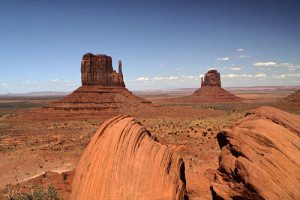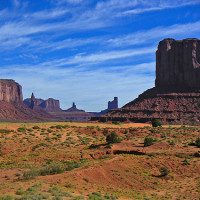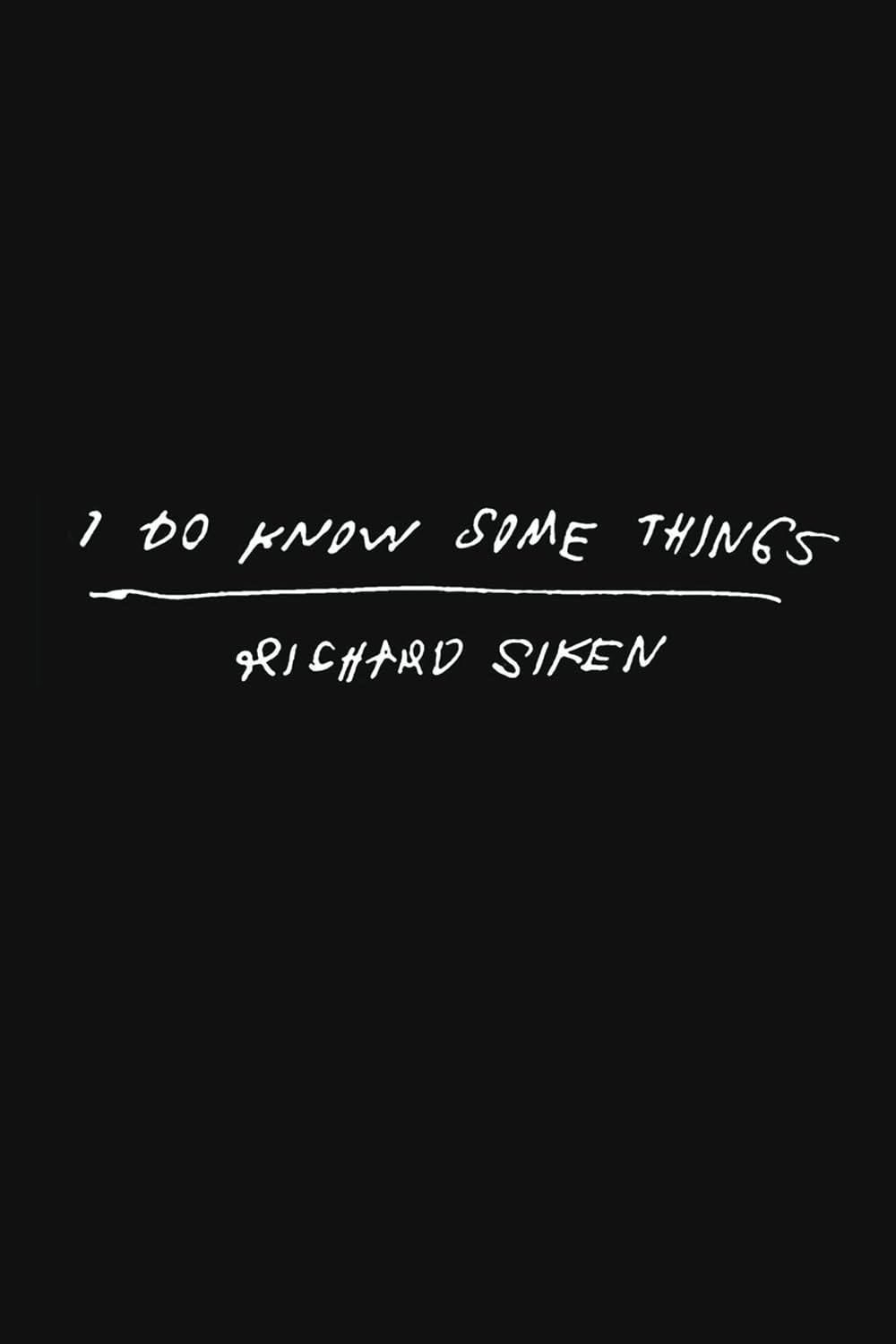I recognized Monument Valley long before I saw the signs. Mesas and buttes rose like cathedrals from a dusty red floor, and in the midday sun, they appeared to be bleached white. I have hiked and camped in the red rock desert, along a perennial stream as wildflowers came into bloom, deep in the canyons of the Green River, in an unexpected winter storm. The desert, with its endless light and rock, diminutive plant life, and vistas that scorched red to the horizon, had been a revelation, but by the time I came to Monument Valley, a part of the landscape had already seeped into me. The scale of the view no longer jolted me as it once did. It was instead a kind of homecoming.
Monument Valley was something else altogether. After a hundred or so miles of desert at seventy miles per hour, the views began to blend into one another, bringing to mind Edward Abbey’s rant, “A man on foot, on horseback, or on a bicycle will see more, feel more, enjoy more in one mile than the motorized tourists can in a hundred miles.” But as I drove over the last hill, I saw three buttes rise from the wide open valley, giant orange sandstone columns atop ruffled skirts of dark mudstone. The word monument came to mind, and I said aloud, “That has to be Monument Valley.” The landscape stood out, but I also had an uneasy sense of déjà vu, as if the image had already been imprinted in my memory.
I knew that the valley was the setting for John Ford’s 1939 Western Stagecoach, the film that gave John Wayne his breakout role as the Ringo Kid. Here’s the thing: I grew up fourteen time zones away, on a crowded island unimaginable in the red rock desert. As a child, I had watched my share of Westerns, though between my dissociation at the time and the tropes of the genre, in my mind they collapsed into a sea of mountains, deserts, gunfights, and chases. The only film I distinctly remember is Paul Newman and Robert Redford’s Butch Cassidy and the Sundance Kid. To this day I am still unsure whether I had seen Stagecoach in those years. Evidently my parents did, for it was they who wanted to visit this shrine to Hollywood.
When I got back to Denver, I borrowed Stagecoach from the public library. A motley group of strangers ride a stagecoach from Tonto, Arizona to Lordsburg, New Mexico: a pregnant young wife on the way to reunite with her cavalry officer husband, an alcoholic doctor and a prostitute driven out of town, a banker who had embezzled the payroll, a whiskey salesman, and a Southern gambler. Before they leave Tonto, the cavalry tells them that the Apache warrior Geronimo is on the warpath, but they all have to get to Lordsburg and the stagecoach leaves. Along the way, they encounter the Ringo Kid, who has broken out of jail and wants to avenge his father and brother, but his horse is injured. The marshal, riding shotgun, recognizes him and takes him into custody.
The scenes in which the stagecoach runs from one town to another show the Mittens and the Merrick Butte, the three monoliths at the center of the valley, as the backdrop, and after a while I imagined the stagecoach running in circles around Monument Valley. In the film, the landscape is stripped of its history and memory and presented instead as an aesthetic phenomenon. It also reflects the rugged masculinity of the hero, at once silent and stoic, his strength derived from the voluptuous austerity of the desert, even though John Wayne seemed to me more like an awkward kid than a paragon of manhood.
Like the American desert, the Kid is located outside of civilized society, without ties to family or culture, loyal only to a higher sense of honor. He is the only one who treats the prostitute Dallas with dignity and they fall in love. At a stop before the final stage to Lordsburg, she helps him escape, but when he rides out into the landscape, he sees Apache smoke signals and turns back. The stagecoach leaves despite the warning signs and a band of Apaches ambush it. The marshal removes the Kid’s handcuffs and hands him a gun, and the Kid rises to the occasion. He rides into Lordsburg in the driver’s seat, the ostensible hero of the adventure, but I thought the landscape to be the central character in the film.
My parents are not walkers, so I went to the trail around the Mittens alone. I came to a dirt road. In the glare I made out the silhouette of a house. Monument Valley lies in the Navajo Nation and a few families continue to live here. A few more steps and I was glad to find the trail again; I did not want to trespass into another’s home. Or perhaps, as yet another Hollywood pilgrim, I was already trespassing. The Navajos call this place Tse’Bii’Ndzisgaii, of which I have heard a number of translations; a Navajo guide I asked said its emotional meaning cannot be translated but it approximates White Light Shining on Rocks. Unlike Monument Valley, it is descriptive rather than prescriptive, concrete instead of abstract.
 At the far end of West Mitten, far from the shade of the mesa, I looked out at the desert. Cliff roses, Mormon tea, and sagebrush dotted the sand. The air was still. The rocks belied the ancient processes of uplift and erosion. I thought of this moment when I saw the trailer for Stagecoach. It begins with scenes of airplanes and trains in motion. The voiceover says that before this era of industrialization and acceleration, the stagecoach was the way to travel. The visual then cuts to a stagecoach running through Monument Valley. In contrast to the machines, the horses represent the primitive forces of nature. The Western, I saw, appeals to this timelessness, this nostalgia for a primordial world.
At the far end of West Mitten, far from the shade of the mesa, I looked out at the desert. Cliff roses, Mormon tea, and sagebrush dotted the sand. The air was still. The rocks belied the ancient processes of uplift and erosion. I thought of this moment when I saw the trailer for Stagecoach. It begins with scenes of airplanes and trains in motion. The voiceover says that before this era of industrialization and acceleration, the stagecoach was the way to travel. The visual then cuts to a stagecoach running through Monument Valley. In contrast to the machines, the horses represent the primitive forces of nature. The Western, I saw, appeals to this timelessness, this nostalgia for a primordial world.
In 1893, the historian Frederick Jackson Turner wrote that the frontier, with its land free for the taking, shaped the American spirit of innovation and democracy. The land settlement patterns described in the 1890 U.S. Census indicated that the frontier had disappeared. The Western was in a way a reaction to this closing of the frontier. It mythologized the ideals of individualism and adventure in the cowboy hero. He is often an outlaw, a man of courage and honor despite, or perhaps precisely because of, his outsider status. When I watched the Westerns again, I finally understood the appeal of the Harvard and Yale boy turned brush-clearing Texan cowboy George W. Bush. He wore the mannerisms of an ancient hero.
In the Westerns, modernity is equated with culture, which is in turn associated with the degradation of the spirit. In Stagecoach, only the Ringo Kid treats the prostitute as an equal, while the others shun her. Culture is conformity and the status quo, while nature represents the individual conscience, authority, and morality, which curiously echoes the ethos of transcendentalists such as Thoreau and Emerson. Ironically, it was in film, a technology that, like trains and airplanes, allows us to transcend the limits of nature and obliterate the sensory experience, that the Western found its apotheosis. Film combines the narrative drive of story with the visual qualities of photography, which is to say, it allows us to frame the hero’s quest in a majestic landscape.
There is something to be said about walking, putting one foot before another in the sand, the desert heat on my back, and nothing between my skin and the sky. I watched thunderclouds gather in the distance. The celestial drama fascinated me, but I was also trying to time its arrival; I had nowhere to hide in a lightning storm. As I walked I imagined myself itinerant in the landscape, the petty concerns of everyday life receding, and nature an encounter without the mediation of a lens. I saw the seduction of this vision, though I also knew that it was planted in me long ago.
***




